Friday, 17 May 2013: Les Baux
Written Sunday, 2 June 2013
First thing after breakfast, I walked back down to the lot where we'd left the car, to find it all by itself—all the other cars parked around it were gone. To make certain the car could be left there for another hour until we were ready to make our planned day trip to Les Baux, I went into the adjacent Office de Tourism to ask, only to be told "That's not a parking area; that's the sidewalk!" Well, drat. I hadn't yet gotten a ticket, so I extricated the car, squeezing it back through the narrow gap, and set off in search of actual parking. All the lots I passed (which were colinear with and, except for the presence of pay-and-display machines, looked just like the sidewalk I had just left) were full, so I turned into the parking ziggurat I had admired the day before, where I found plenty of room. So now I'm officially a French-style driver; I parked on the sidwalk overnight and got away with it!
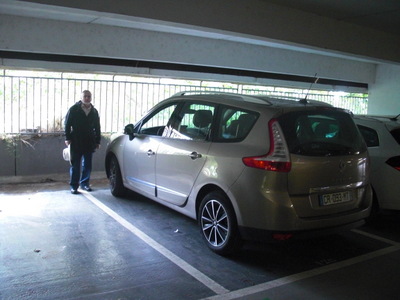
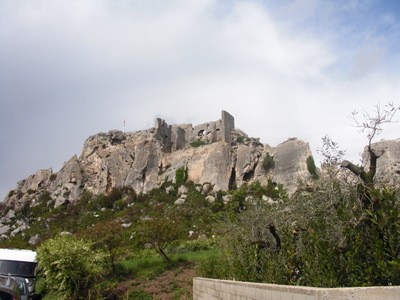 Here's our car, a seven-passenger Renault Scenic. That sounds huge, but with the back three seats folded down to make space for luggage, two people in the front, two people in the back, and the suitcase that still wouldn't fit on the middle seat between them, it was a little snug for four travellers.
Here's our car, a seven-passenger Renault Scenic. That sounds huge, but with the back three seats folded down to make space for luggage, two people in the front, two people in the back, and the suitcase that still wouldn't fit on the middle seat between them, it was a little snug for four travellers.
For the trip to Les Baux, though, we were only two, without luggage, so we had plenty of room. I'd always known of Les Baux as the locality for which bauxite, aluminum ore, was named, so I had always pictured it as rather an industrial place where aluminum was mined. In fact, the local bauxite deposits were exhausted long ago, and the place had been an important historical site long before its mining fame. Today, one sees no sign of mining or industry, just a spectacular ruined castle (now a major tourist draw) perched on a tall butte, surrounded by agriculture and also-spectacular mountainous terrain.
We followed the directional signs up the winding approach road, overshot the main parking lots (which were full anyway, and had to turn around to try again. This time, we just parked by the side of the road down where the tour buses were parked and walked back up. The photo to the right is what we saw from our parking place, on the "blind" side of the butte. The entrance and village are on the other side.

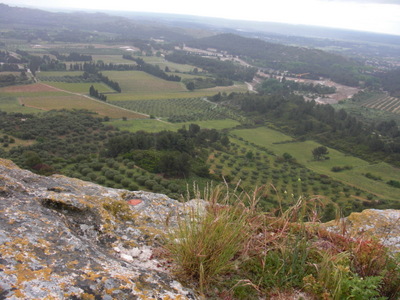 The diagram on the left shows the top of the butte, with the village on the near edge and the ruins of the castle on the far edge. We entered at the left-hand side and walked the length of the village to the entrance to the castle area proper (marked on the diagram by a little black-and-white rectangular "you are here" label.
The diagram on the left shows the top of the butte, with the village on the near edge and the ruins of the castle on the far edge. We entered at the left-hand side and walked the length of the village to the entrance to the castle area proper (marked on the diagram by a little black-and-white rectangular "you are here" label.
At the right is a sample of the gorgeous views from the top, out over the orchards (both fruit and olive) and vines below.
Unlike many mountain-top fortresses, Les Baux had no well. The castle's only source of water (at least when besiegers prevented it from being carried up from the valley below) was cysterns fed by runoff from an area out on the large stony point at the right-hand end of the butte that was paved with stone and guttered for the purpose.

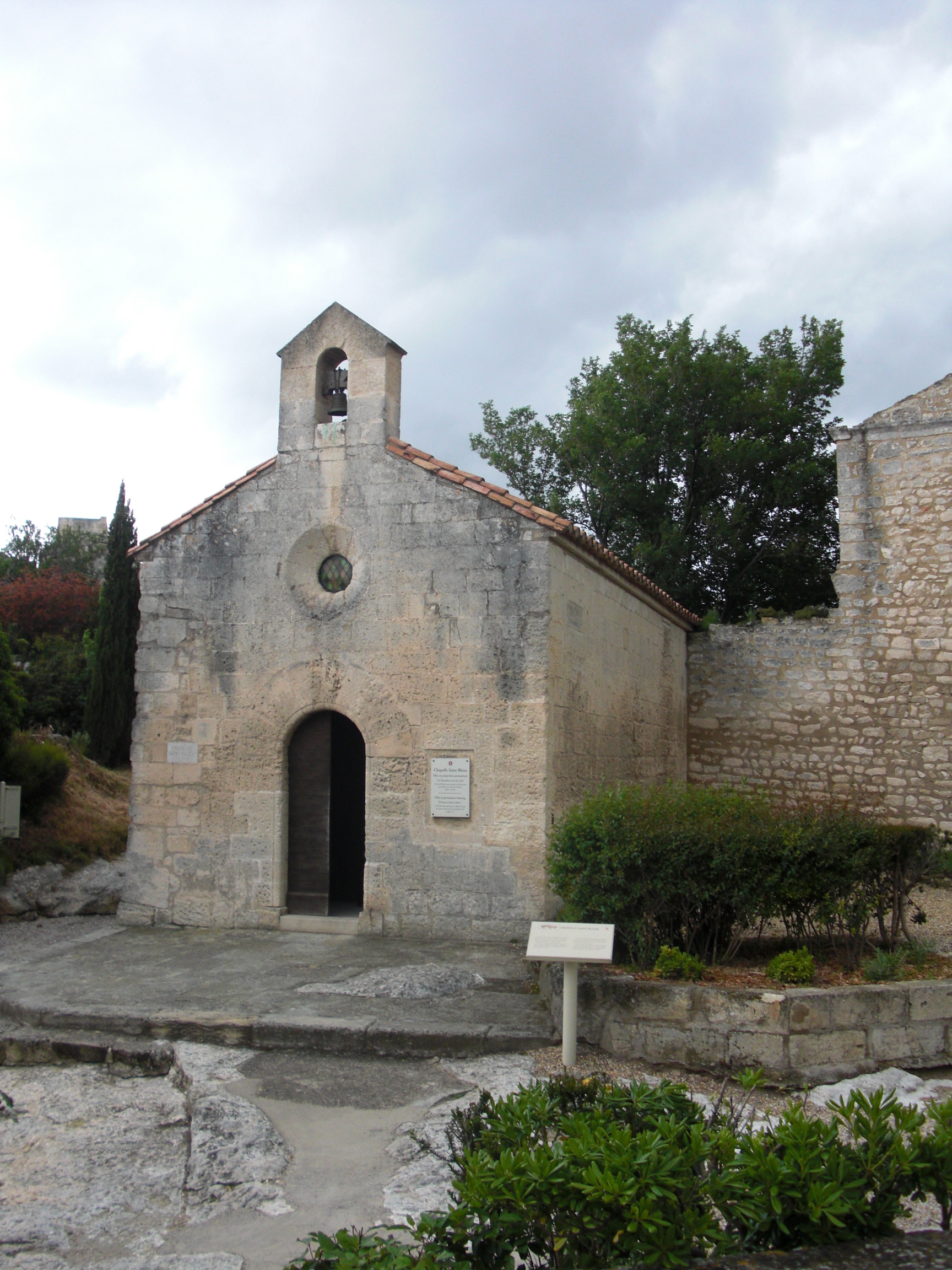
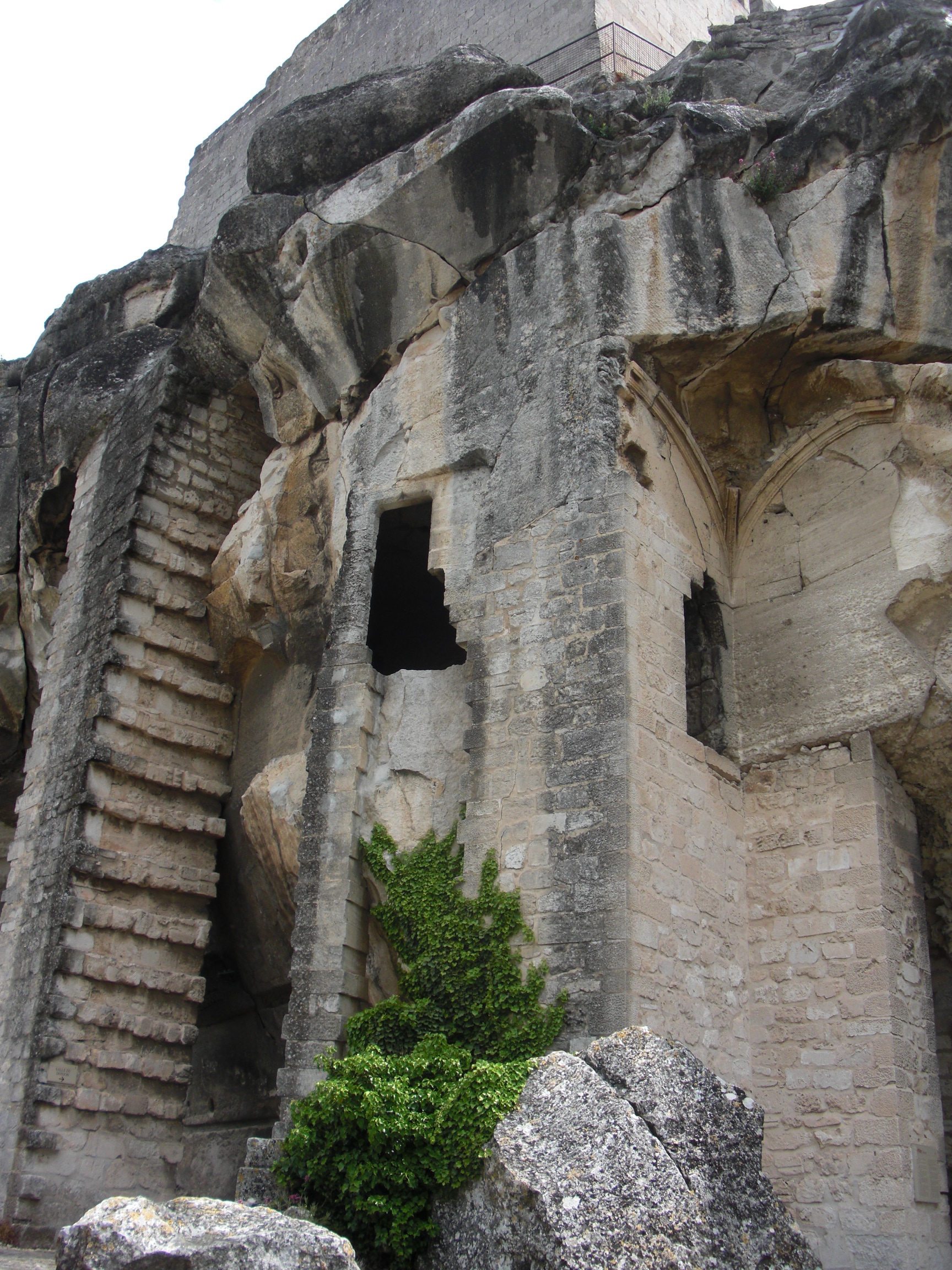
At the left above are a little side street we walked by in the village, the chapel of Sainte Blaise (near the entrance to the castle area), and a portion of the ruined castle, showing its complex combination of building and excavation: some parts were constructed, but others hollowed out of the solid rock.
Just as we arrived, the rain started, so we took shelter in the chapel and watched a beautiful film called "Provence from the Air," consisting of shots of the region's most spectacular terrain and architecture taken from a helicopter (the shadow of which was often visible on the ground below).

 Eventually, the rain abated, and we were able to explore the castle area. Wildflowers were everywhere. The poppies and mustard (left) were growing down by our parking area. The magenta flowers (Centranthus ruber, red valerian) were up on the butte and were, in fact, ubiquitous all over Provence.
Eventually, the rain abated, and we were able to explore the castle area. Wildflowers were everywhere. The poppies and mustard (left) were growing down by our parking area. The magenta flowers (Centranthus ruber, red valerian) were up on the butte and were, in fact, ubiquitous all over Provence.
Many species of tiny plants were in bloom in cracks in the rock, all over the top of the butte. I took quick snapshots of them but didn't take time to photograph them properly. Most of them were familiar from rock gardens I've visited over the years, but some I couldn't even place to family.

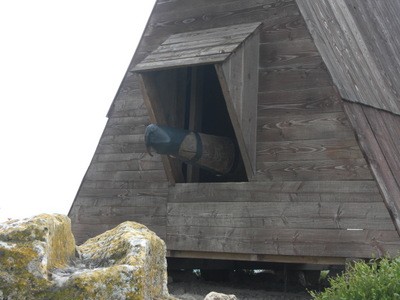 A tourist draw at Les Baux is the working models of medieval siege weapons, which are actually fired during the height of the season (July and August; we were too early). In fact, while we were walking out near the paved area, we encountered signs saying, "Warning! Firing range!"
A tourist draw at Les Baux is the working models of medieval siege weapons, which are actually fired during the height of the season (July and August; we were too early). In fact, while we were walking out near the paved area, we encountered signs saying, "Warning! Firing range!"
Excellent illustrated information panels explained the differences among, e.g., the "couillard," the "catapult" (aka, "baliste"), and the "trebuchet." They also had a full-size working model of a "bélier," i.e., a battering ram. It took the form of a long, rolling A-frame with a steeply sloping roof designed to shed all the rocks, boiling oil, and flaming arrows people on the ramparts would be hitting it with while it battered the gates. Inside it, a huge log with a metal cap on the end was suspended on chains from the A-frame's ridgepole, so that people inside could swing it back and forth against whatever was being battered, without actually having to lift it. That's a photo of its business end on the right.
In other areas were an archery range (wisely placed in a sunken stone room, where the arrows couldn't go far astray), a range for demonstration of cross-bow firing, and an arena in which to watch sword-fighting demonstrations.

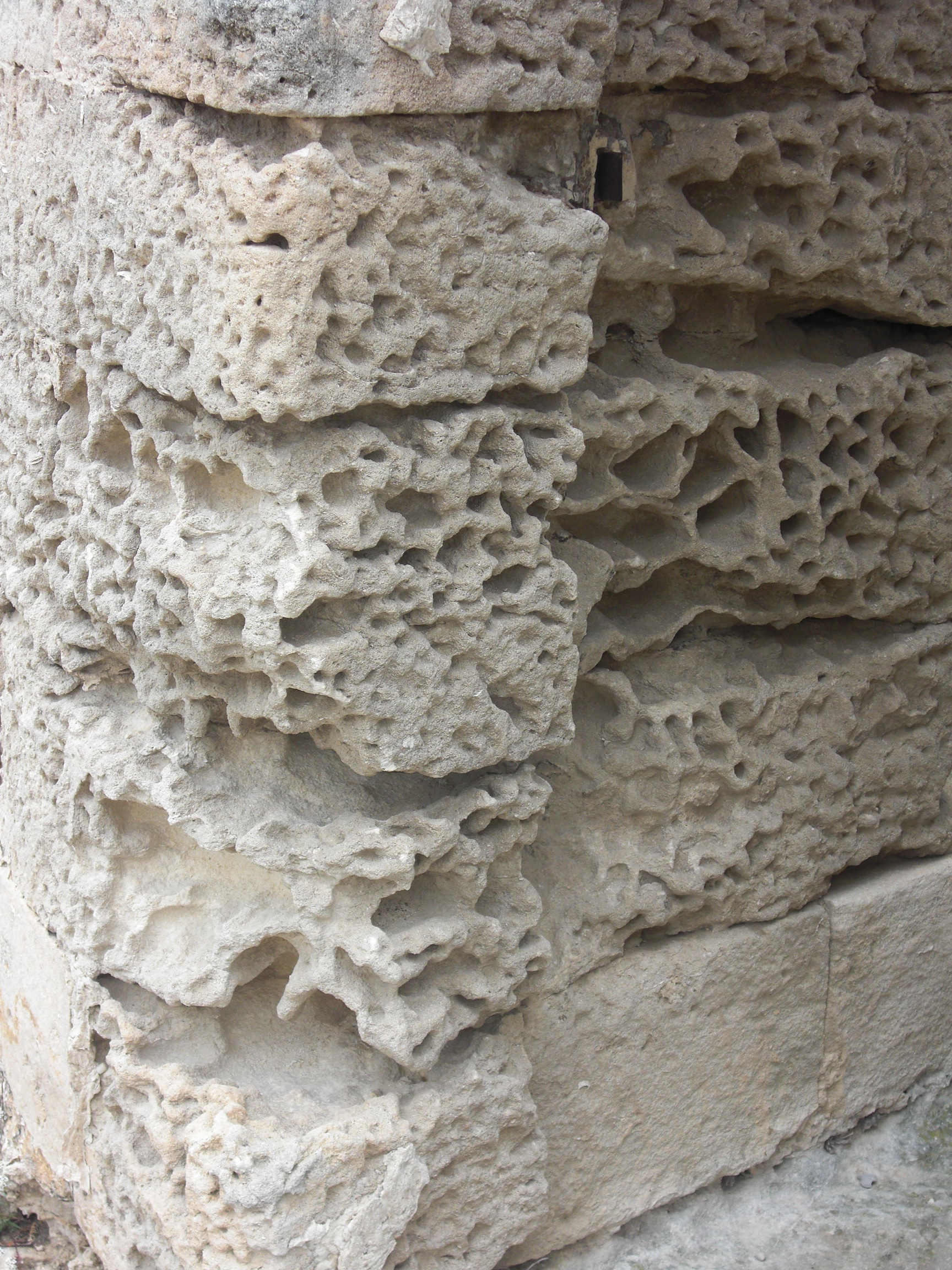 Here's another photo of some of the structure built right into the stone, and on the right a closer view of the amazing erosion that has taken place. Presumably acid rain is doing a number on the calcareous rock.
Here's another photo of some of the structure built right into the stone, and on the right a closer view of the amazing erosion that has taken place. Presumably acid rain is doing a number on the calcareous rock.
The audioguide was excellent, pointing out many architectural details and complementing, rather than duplicating, the content of the many, many explanatory panels. We never did have time to listen to all the entries, which ramified—when you finished listening to the part about the ruined bake-house, you were told additional numbers to press to find out more about what people of different classes ate in the middle ages and how labor was apportioned. Even if we'd allowed a whole day (and our feet would hold out that long) and hadn't lost time to the rain, we couldn't have seen and learned everything, especially if the demonstrations had been going on; definitely a worthwhile visit.

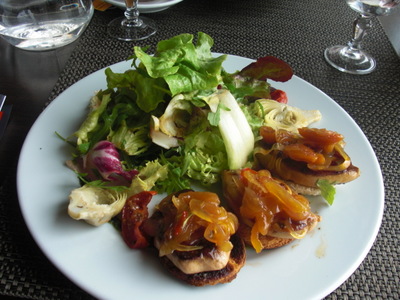 We found lunch on our stroll back down through the village, at the Museum Café. David had a salad with raw ham, olives, potatoes, and a fromage-blanc-based herb dressing.
We found lunch on our stroll back down through the village, at the Museum Café. David had a salad with raw ham, olives, potatoes, and a fromage-blanc-based herb dressing.
I had salad with sautéed foie gras on toast, topped with a delicious onion marmelade and accompanied by confit tomatoes and artichoke hearts. Yummy.
The village had its share of souvenir shops, but it seemed far more residential and far less commercialized than, say, Mont Saint Michel.
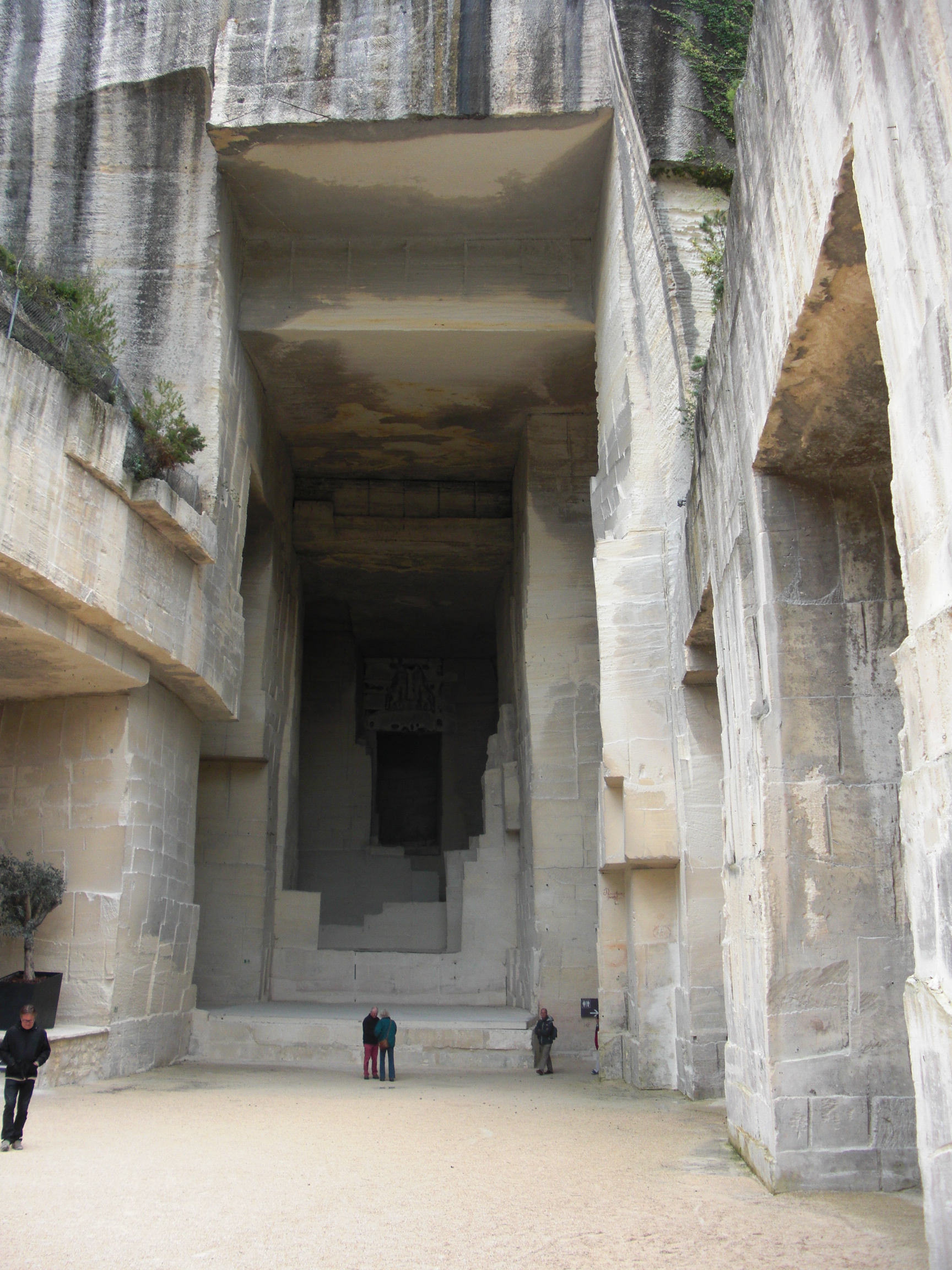
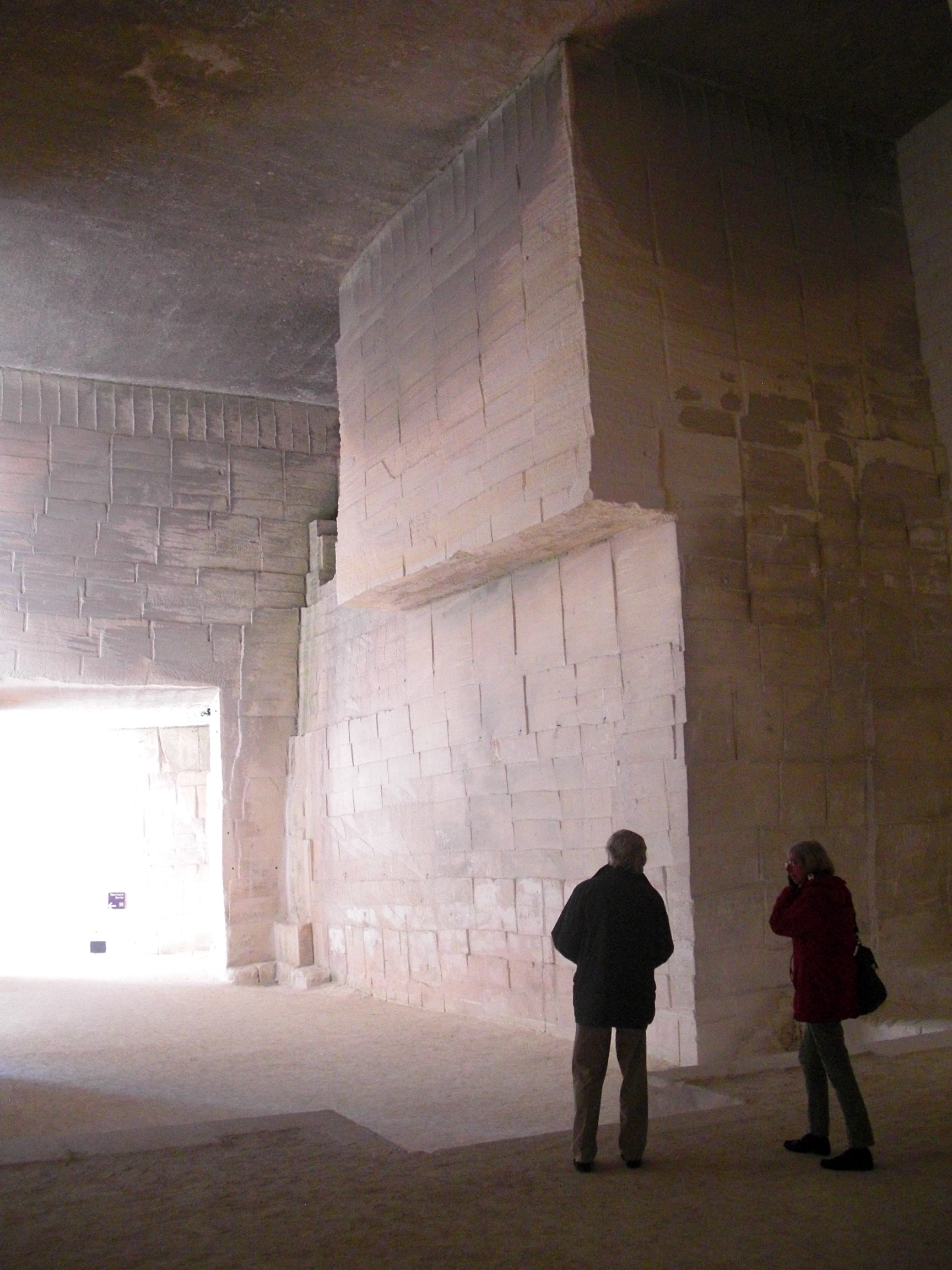

Our tickets were good both for Les Baux itself and for something called the "Carrière de la Lumière," i.e., the quarry of light. It was within walking distance, so we hiked over there—a little rough and muddy, but easily doable.
The premise was odd. The quarry is really a quarry—the source of large amounts of calcareous building stone—but like those in the Loire Valley, it's not an open pit but a huge, ramifying set of tunnels. The tunnels are huge in both senses; that is, they are quite extensive, and they are also very large, as you can see from the photo of the entrance at the left above.
Inside, you can see the rectangular traces on the walls of the big blocks of rock that have been removed. Somewhere along the line, somebody had the idea that those tall, rough, white walls would make good surfaces on which to project images. When you walk in through the final door into the main galleries, you find yourself in darkness, surrounded by huge projected images. When we arrived, the images were of sea life, real and imaginary, sliding and shifting around the walls, but that was apparently just the "short subject." The real show was paintings by the impressionists (and pre- and postimpressionists) projected on every vertical surface. The floors were on several levels, connected by ramps and stairs, and the gigantic chambers were supported by gigantic square pillars left for the purpose during the quarrying process. Projectors were strategically placed to put images on every side of every pillar, every wall, in such a way that the passing spectators never cast shadows on them. The images came and went, shifted and slid, to be replaced by others. You saw a different selection, depending on where you stood or wandered. In the image on the right (of a famous Monet), note the size of the people standing nearby—many of the images were several stories tall. I was able to get some reasonable pictures, enough to show the effect, shooting without flash, but I was amazed at the number of people around me who were trying to take flash pictures of projected images! The people I'd like to smack upside the head, though, are the taggers who had defaced so many of the walls.
In a separate gallery, this one arranged theater-style with rows of seats, a specially made Jean Cocteau film (consisting of exerpts of several of his other films) was running continuously. In it, Cocteau himself appears and addresses the audience. In both that sequence and the exerpts from the other films, he appears throughout with large staring eyes painted on his closed eyelids, lending a very surreal look to the whole thing.
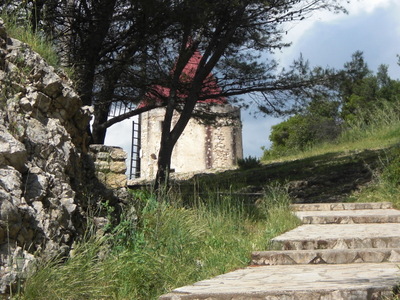
 On the way back to Arles, we stopped briefly in Fontvielle, just to see the famous mill where Alphonse Daudet lived when he wrote Lettres de Mon Moulin. This photo (left) is the best we could get without actually paying for parking and admission. Fontvielle seems a very literary little place. Full half its roads are named for authors and poets.
On the way back to Arles, we stopped briefly in Fontvielle, just to see the famous mill where Alphonse Daudet lived when he wrote Lettres de Mon Moulin. This photo (left) is the best we could get without actually paying for parking and admission. Fontvielle seems a very literary little place. Full half its roads are named for authors and poets.
Back in Arles, we had the car valet again, and I moved to my new room. In the evening, we once again had to walk only around the block to the Atelier de Jean-Luc Rabanel for dinner. Alas, the experience did not go well. On the right is a photo of David in the "lounge" area, where we were seated for the (count 'em five) amuse-bouches.
The restaurant has no menu; the meal is entirely chef's choice, supposedly built around 13 flavors, though we couldn't necessarily tell which 13 among all the stuff they brought us. Because we never saw it written down, I have no record of what was in the dishes except my photos and what I could remember and note from the verbal descriptions presented by the wait staff. They started by asking us about allergies and aversions—avocado for me, cucumbers and melon for David—and about beverages—wines for David, still water for me&mdsh; and started bringing food.
Unfortunately, the service was unbelievably irritating. Rabanel doesn't feel a dish is complete unless it has at least 19 ingredients (even though the whole thing amounts to four bites), and he makes the staff memorize the list for each course. Each time we were brought a dish, the server set it down, took a step backward, listed its contents softly in a rapid mechanical monotone, and was turning away to leave before the final "enjoyyourmeal" was out of her mouth. We could understand the French just fine, but if anyone at another table so much as spoke, a whole phrase was drowned out, and if you missed a word, you had no chance to ask for repetition. If you made any sign at all, the server immediately asked if you'd rather hear it in English, and when we said no, zoomed away before we could, e.g., ask for a repetition in French. Another server would appear to set out the silverware for the next course before we had finished the last, but that didn't mean that the service was that rapid—when we finished one course, we often waited a while for the next. Eventually, I just noted as many ingredients as I could catch (and remember by the end); sometimes, I could fill in by listening to the spiel when it was repeated for a neighboring table, but I also discovered in that way that the descriptions did not always match—I don't know whether the ingredients changed in the course of the evening or whether not all the waiters got the list right. Many of the dishes were very good, and a couple were excellent, but the whole thing lacked the magic synergism of flavors we encountered at, e.g., Maison de Bricourt in Brittany.

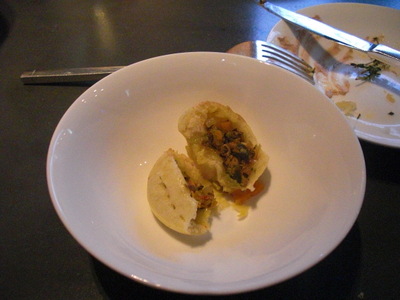 We couldn't tell what was an amuse-bouche and what was a course, so I'll just number them all.
We couldn't tell what was an amuse-bouche and what was a course, so I'll just number them all.
Course 1: Asparagus cooked with orange and ginger with a hazelnut sauce (in the little ceramic dish), roasted in a crust of bread. That's what the waiter said, but clearly the asparagus, though served in a crust of bread, was not roasted in it. Pretty good.
Course 2: Steamed bun with a soufflé of Provençal vegetables and an escabeche of mussels inside, served with a slightly spicy dipping sauce. Also pretty good.
Unfortunately, at this point, another party was seated at a nearby table, and hearing the descriptions got difficult.

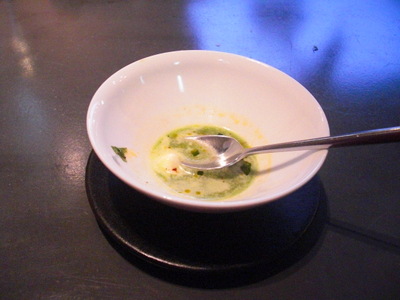 Course 3: A Provençal coconut shortbread cookie with onions, frozen vinaigrette, a piece of mackerel, a cucumber flower with the baby cucumber attached, and and a other stuff I couldn't because our neighbors spoke. Caramelized citrus sauce around the edges. As soon as the server confirmed my identification of the cucumber flower, I made a move as if to speak—we had just specified at the beginning of the meal: no cucumber—but David made a sign to let it go. The server caught the by-play and immediately offered to repeat the whole thing in English, which we declined. She went away, baffled, and we then tried to eat the dratted thing with a demitasse spoon, the only implement provided (ever tried to eat a shortbread cookie and a cucumber flower with a spoon?). We'd have asked for forks, but once our server disappeared another didn't come into the room until long after we'd given up and finished the course. Okay, but absolutely no synergism.
Course 3: A Provençal coconut shortbread cookie with onions, frozen vinaigrette, a piece of mackerel, a cucumber flower with the baby cucumber attached, and and a other stuff I couldn't because our neighbors spoke. Caramelized citrus sauce around the edges. As soon as the server confirmed my identification of the cucumber flower, I made a move as if to speak—we had just specified at the beginning of the meal: no cucumber—but David made a sign to let it go. The server caught the by-play and immediately offered to repeat the whole thing in English, which we declined. She went away, baffled, and we then tried to eat the dratted thing with a demitasse spoon, the only implement provided (ever tried to eat a shortbread cookie and a cucumber flower with a spoon?). We'd have asked for forks, but once our server disappeared another didn't come into the room until long after we'd given up and finished the course. Okay, but absolutely no synergism.
Course 4: Green pea soup with mint, garnished with a dollop of fromage-blancice cream, a pansy petal, and chive flowers; a few corn kernels in the bottom. Excellent! I'm glad they brought us another spoon and didn't expect us to eat it with, e.g., a knife.
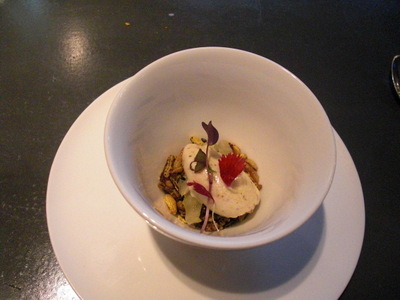
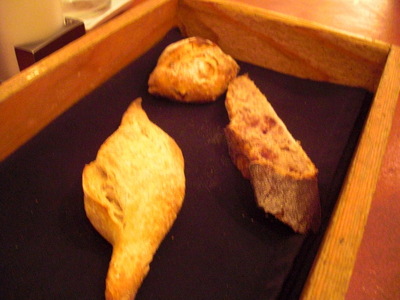 Course 5: "Camargue breakfast": crispy puffed camargue rice, shaved fennel, almond ice cream, a shiso sprout, and a dianthus petal. Interesting; I'd never had puffed wild rice before.
Course 5: "Camargue breakfast": crispy puffed camargue rice, shaved fennel, almond ice cream, a shiso sprout, and a dianthus petal. Interesting; I'd never had puffed wild rice before.
At this point, David had long since been served his wine, but no water had been forthcoming. Apparently you don't get water until this point in the meal, when you are moved from the preliminary dining room to the main dining room. I hadn't specified a brand of water, as I assumed I'd be served the same "house" water we'd had two nights before at Bistrot d'à Coté, and sure enough I was—it arrived in the tall cylindrical Cryo bottles, so the water so grandly described two nights earlier as "our own water" was in fact filtered tap water.
At our new table, we were offered bread from a trolley laden with many, many flavors. I chose a cranberry-chestnut bread and a fig-apricot bread; David chose a small baguette. They were arranged on a square tray and brought to the table (photo on the right), where they sat for most of the meal. I did finally taste mine, so see what they were like, and they were okay.
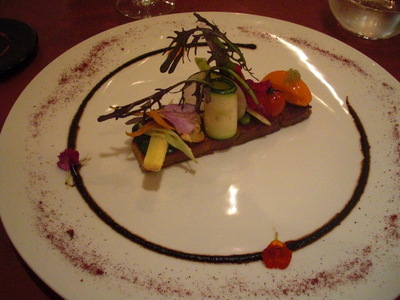
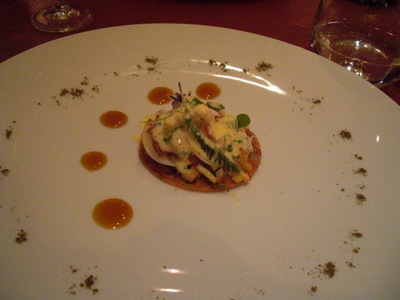 Course 6: A slice of toasted rosemary focaccia with seasonal vegetables, tomato and bell pepper ice cream, and Japanese flying fish eggs. The sauce around the edge was a balsamic vinegar and beet reduction.
Course 6: A slice of toasted rosemary focaccia with seasonal vegetables, tomato and bell pepper ice cream, and Japanese flying fish eggs. The sauce around the edge was a balsamic vinegar and beet reduction.
Course 7: A crisp cracker topped with thinly sliced lobster and maybe turnip or black radish, a celery brunoise (i.e., finely diced celery root), and an urchin-roe beurre blanc. Garnished with borage and chive flowers and what looked like a leaf of salad burnet. More dots of caramelized orange around the sides. Pretty good. The lobster itself was delicious.
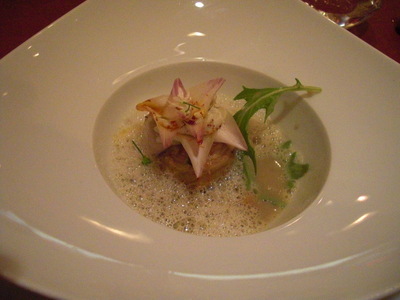
 Course 8: Artichokes bariguole with a juice of artichokes and pata negra (a spanish cured-pork product similar to ham). I didn't catch any mention of it by the server, but I found a bite of oyster in the bottom. The arrangement of tiny purple artichoke petals on top was lovely.
Course 8: Artichokes bariguole with a juice of artichokes and pata negra (a spanish cured-pork product similar to ham). I didn't catch any mention of it by the server, but I found a bite of oyster in the bottom. The arrangement of tiny purple artichoke petals on top was lovely.
Course 9: A diver scallop, a slice of raw artichoke, and a zucchini flower (with baby zucchini) stuffed with red bell pepper and chorizo, all resting on a green purée of ginger and cilantro. The scallop is mostly hidden by the artichoke slice.
Somewhere along in here, I forget between which courses, I saw Rabanel himself in the kitchen call the cooks together, speak forcefully and sternly to them, then dismiss them to scramble back to their posts to redouble their efforts. David read somewhere that he tends to do that.
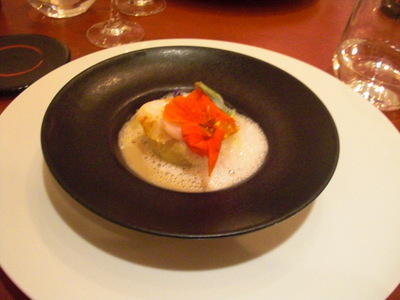
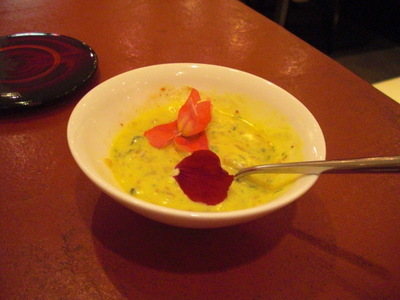 Course 10: Brandade de morue (i.e., a mixture of potatoes and reconstituted, cooked, and flaked salt cod) with a bit of cod on top and cockles on the side. Garnished with a nasturtium flower and a leaf of "oyster plant" (genus Mertensia, a bluebell), described by the server as tasting like oysters. I accordingly took a bite; big mistake. Yes, at first bite it tasted distinctly oyster-like, but the flavor was very lingering became increasingly distasteful.
Course 10: Brandade de morue (i.e., a mixture of potatoes and reconstituted, cooked, and flaked salt cod) with a bit of cod on top and cockles on the side. Garnished with a nasturtium flower and a leaf of "oyster plant" (genus Mertensia, a bluebell), described by the server as tasting like oysters. I accordingly took a bite; big mistake. Yes, at first bite it tasted distinctly oyster-like, but the flavor was very lingering became increasingly distasteful.
"Light" béarnaise sauce: On the right is the sauce for course 11, which was mixed for us at the table. The server brought a raw egg yolk, a creamy white herb-flecked mixture, and some third ingredient and ceremoniously mixed them together for us, not neglecting to garnish the mixture with more flower petals. She emphasized that the result was a béarnaise sauce "without a bit of butter." But when asked she admitted that the creamy white mixture was whipped cream (ca. 50% butter fat), so I'm not sure what the point was.

 Course 11: Grilled tuna with roasted vegetables. I watched this dish being assembled at the kithen pass-through, first for a couple of neighboring tables and then for us. It was plated, then placed under the heat lamps, where were pulled down low over it, as though to glaze the surface or some such. Then, just before serving, somebody piled a good-sized handful of fresh thyme on top, whipped out a blowtorch, and set the whole thing ablaze. The servers tried to get the plate to the table still flaming, but usually it arrived with the the thyme reduced to glowing, smoking embers. This course was just too much. , served with herbs flaming. The course that was too much. We'd already eaten a lot of food, we were increasingly irritated with the waiters, I still had the icky, lingering taste of the oyster plant in my mouth, the tuna was badly overcooked, the vegetables were dry-roasted and of no great interest, the sauce was very rich, and the tuna was topped with an entirely raw quail egg.
Course 11: Grilled tuna with roasted vegetables. I watched this dish being assembled at the kithen pass-through, first for a couple of neighboring tables and then for us. It was plated, then placed under the heat lamps, where were pulled down low over it, as though to glaze the surface or some such. Then, just before serving, somebody piled a good-sized handful of fresh thyme on top, whipped out a blowtorch, and set the whole thing ablaze. The servers tried to get the plate to the table still flaming, but usually it arrived with the the thyme reduced to glowing, smoking embers. This course was just too much. , served with herbs flaming. The course that was too much. We'd already eaten a lot of food, we were increasingly irritated with the waiters, I still had the icky, lingering taste of the oyster plant in my mouth, the tuna was badly overcooked, the vegetables were dry-roasted and of no great interest, the sauce was very rich, and the tuna was topped with an entirely raw quail egg.
As usual, the description was mechanical and difficult to follow. David finally lost it and told the waitress angrily that, yes, he wanted to hear it in English and slowly. In the face of his reaction, the waitress lost all the English she ever knew and stood there stammering. When David suggested she send another waiter, one who could describe the dish in English, she sent (after considerably delay) a man whose English description was so halting and garbled that it was far worse than the French.
I couldn't really face the dish. I scraped off the raw egg and ate about half the tuna with some of the "light" béarnaise, tasted a couple of the vegetables to give the kitchen a chance, but abandoned the rest, as you see here.
Course 12: Fortunately, this was the first dessert (or maybe a palate cleanser): ginger-basil-thyme sorbet with a sprout of shiso. Underneath it was a strange glutinous gel with a different herbal flavor taste. Anyway, it was cool and acid and succeeded both in cutting the richness and in banishing the oyster plant. Things got a little better from there.

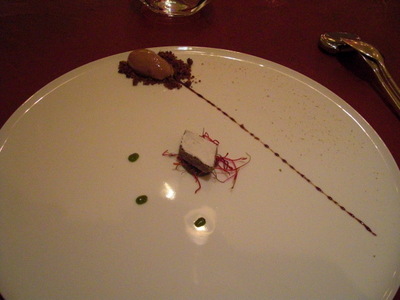 Course 13: A rose made of sweetened slices of pink beetroot (raw but wilted, I guess by soaking in sugar syrup) with passionfruit vinaigrette and a sweetened beet sorbet. Excellent. After the pea soup, this was the second best dish of the meal.
Course 13: A rose made of sweetened slices of pink beetroot (raw but wilted, I guess by soaking in sugar syrup) with passionfruit vinaigrette and a sweetened beet sorbet. Excellent. After the pea soup, this was the second best dish of the meal.
Course 14: A callison d'Aix flavored with black olives on a bed of herb pesto and beet sprouts; chocolate sorbet (?) on the side. Balsamic streak. It was mildly sweet and pretty good. I assume the callison was still basically made of almonds, as it had a dry, crumbly texture that black olives could hardly produce.

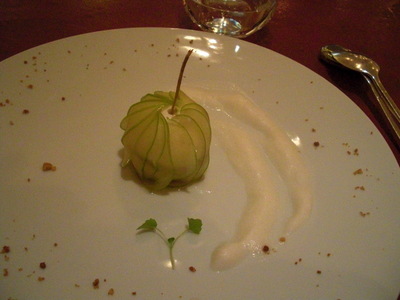 Course 15: More crispy puffed rice, with an assortment of olives and small fresh fruits, and a little white sorbet. A white creamy sauce drizzled over all.
Course 15: More crispy puffed rice, with an assortment of olives and small fresh fruits, and a little white sorbet. A white creamy sauce drizzled over all.
Course 16: A reconstructed Granny Smith apple. They started with a crisp meringue base, on top of which they put layers of coconut sorbet and ginger/Granny Smith sorbet, then clad the whole thing in very thin wilted slices of raw Granny Smith apple and stuck an anise twig in the top as a stem. Coconut froth on the side.
The server suggested that, to get all the flavors into the mouth together, the diner should remove the stem, then crush the whole thing straight downward with the spoon. I tried it, and the result was really very good. Third best dish of the dinner.
Not a stunning success as a dining experience. To be fair, the menu does warn that (despite the prices) this is an "atelier," a studio or workshop, and that what you get is what the chef is working on that day. We realize that in that many courses, of that complexity, a few are likely to be duds, but I'm afraid I have to say that the service, from start to finish, needs a whole lot of work.
previous entry
List of Entries
next entry

 Here's our car, a seven-passenger Renault Scenic. That sounds huge, but with the back three seats folded down to make space for luggage, two people in the front, two people in the back, and the suitcase that still wouldn't fit on the middle seat between them, it was a little snug for four travellers.
Here's our car, a seven-passenger Renault Scenic. That sounds huge, but with the back three seats folded down to make space for luggage, two people in the front, two people in the back, and the suitcase that still wouldn't fit on the middle seat between them, it was a little snug for four travellers.
 The diagram on the left shows the top of the butte, with the village on the near edge and the ruins of the castle on the far edge. We entered at the left-hand side and walked the length of the village to the entrance to the castle area proper (marked on the diagram by a little black-and-white rectangular "you are here" label.
The diagram on the left shows the top of the butte, with the village on the near edge and the ruins of the castle on the far edge. We entered at the left-hand side and walked the length of the village to the entrance to the castle area proper (marked on the diagram by a little black-and-white rectangular "you are here" label.



 Eventually, the rain abated, and we were able to explore the castle area. Wildflowers were everywhere. The poppies and mustard (left) were growing down by our parking area. The magenta flowers (Centranthus ruber, red valerian) were up on the butte and were, in fact, ubiquitous all over Provence.
Eventually, the rain abated, and we were able to explore the castle area. Wildflowers were everywhere. The poppies and mustard (left) were growing down by our parking area. The magenta flowers (Centranthus ruber, red valerian) were up on the butte and were, in fact, ubiquitous all over Provence.
 A tourist draw at Les Baux is the working models of medieval siege weapons, which are actually fired during the height of the season (July and August; we were too early). In fact, while we were walking out near the paved area, we encountered signs saying, "Warning! Firing range!"
A tourist draw at Les Baux is the working models of medieval siege weapons, which are actually fired during the height of the season (July and August; we were too early). In fact, while we were walking out near the paved area, we encountered signs saying, "Warning! Firing range!"
 Here's another photo of some of the structure built right into the stone, and on the right a closer view of the amazing erosion that has taken place. Presumably acid rain is doing a number on the calcareous rock.
Here's another photo of some of the structure built right into the stone, and on the right a closer view of the amazing erosion that has taken place. Presumably acid rain is doing a number on the calcareous rock.
 We found lunch on our stroll back down through the village, at the Museum Café. David had a salad with raw ham, olives, potatoes, and a fromage-blanc-based herb dressing.
We found lunch on our stroll back down through the village, at the Museum Café. David had a salad with raw ham, olives, potatoes, and a fromage-blanc-based herb dressing.



 On the way back to Arles, we stopped briefly in Fontvielle, just to see the famous mill where Alphonse Daudet lived when he wrote Lettres de Mon Moulin. This photo (left) is the best we could get without actually paying for parking and admission. Fontvielle seems a very literary little place. Full half its roads are named for authors and poets.
On the way back to Arles, we stopped briefly in Fontvielle, just to see the famous mill where Alphonse Daudet lived when he wrote Lettres de Mon Moulin. This photo (left) is the best we could get without actually paying for parking and admission. Fontvielle seems a very literary little place. Full half its roads are named for authors and poets.
 We couldn't tell what was an amuse-bouche and what was a course, so I'll just number them all.
We couldn't tell what was an amuse-bouche and what was a course, so I'll just number them all.
 Course 3: A Provençal coconut shortbread cookie with onions, frozen vinaigrette, a piece of mackerel, a cucumber flower with the baby cucumber attached, and and a other stuff I couldn't because our neighbors spoke. Caramelized citrus sauce around the edges. As soon as the server confirmed my identification of the cucumber flower, I made a move as if to speak—we had just specified at the beginning of the meal: no cucumber—but David made a sign to let it go. The server caught the by-play and immediately offered to repeat the whole thing in English, which we declined. She went away, baffled, and we then tried to eat the dratted thing with a demitasse spoon, the only implement provided (ever tried to eat a shortbread cookie and a cucumber flower with a spoon?). We'd have asked for forks, but once our server disappeared another didn't come into the room until long after we'd given up and finished the course. Okay, but absolutely no synergism.
Course 3: A Provençal coconut shortbread cookie with onions, frozen vinaigrette, a piece of mackerel, a cucumber flower with the baby cucumber attached, and and a other stuff I couldn't because our neighbors spoke. Caramelized citrus sauce around the edges. As soon as the server confirmed my identification of the cucumber flower, I made a move as if to speak—we had just specified at the beginning of the meal: no cucumber—but David made a sign to let it go. The server caught the by-play and immediately offered to repeat the whole thing in English, which we declined. She went away, baffled, and we then tried to eat the dratted thing with a demitasse spoon, the only implement provided (ever tried to eat a shortbread cookie and a cucumber flower with a spoon?). We'd have asked for forks, but once our server disappeared another didn't come into the room until long after we'd given up and finished the course. Okay, but absolutely no synergism.
 Course 5: "Camargue breakfast": crispy puffed camargue rice, shaved fennel, almond ice cream, a shiso sprout, and a dianthus petal. Interesting; I'd never had puffed wild rice before.
Course 5: "Camargue breakfast": crispy puffed camargue rice, shaved fennel, almond ice cream, a shiso sprout, and a dianthus petal. Interesting; I'd never had puffed wild rice before.
 Course 6: A slice of toasted rosemary focaccia with seasonal vegetables, tomato and bell pepper ice cream, and Japanese flying fish eggs. The sauce around the edge was a balsamic vinegar and beet reduction.
Course 6: A slice of toasted rosemary focaccia with seasonal vegetables, tomato and bell pepper ice cream, and Japanese flying fish eggs. The sauce around the edge was a balsamic vinegar and beet reduction.
 Course 8: Artichokes bariguole with a juice of artichokes and pata negra (a spanish cured-pork product similar to ham). I didn't catch any mention of it by the server, but I found a bite of oyster in the bottom. The arrangement of tiny purple artichoke petals on top was lovely.
Course 8: Artichokes bariguole with a juice of artichokes and pata negra (a spanish cured-pork product similar to ham). I didn't catch any mention of it by the server, but I found a bite of oyster in the bottom. The arrangement of tiny purple artichoke petals on top was lovely.
 Course 10: Brandade de morue (i.e., a mixture of potatoes and reconstituted, cooked, and flaked salt cod) with a bit of cod on top and cockles on the side. Garnished with a nasturtium flower and a leaf of "oyster plant" (genus Mertensia, a bluebell), described by the server as tasting like oysters. I accordingly took a bite; big mistake. Yes, at first bite it tasted distinctly oyster-like, but the flavor was very lingering became increasingly distasteful.
Course 10: Brandade de morue (i.e., a mixture of potatoes and reconstituted, cooked, and flaked salt cod) with a bit of cod on top and cockles on the side. Garnished with a nasturtium flower and a leaf of "oyster plant" (genus Mertensia, a bluebell), described by the server as tasting like oysters. I accordingly took a bite; big mistake. Yes, at first bite it tasted distinctly oyster-like, but the flavor was very lingering became increasingly distasteful.
 Course 11: Grilled tuna with roasted vegetables. I watched this dish being assembled at the kithen pass-through, first for a couple of neighboring tables and then for us. It was plated, then placed under the heat lamps, where were pulled down low over it, as though to glaze the surface or some such. Then, just before serving, somebody piled a good-sized handful of fresh thyme on top, whipped out a blowtorch, and set the whole thing ablaze. The servers tried to get the plate to the table still flaming, but usually it arrived with the the thyme reduced to glowing, smoking embers. This course was just too much. , served with herbs flaming. The course that was too much. We'd already eaten a lot of food, we were increasingly irritated with the waiters, I still had the icky, lingering taste of the oyster plant in my mouth, the tuna was badly overcooked, the vegetables were dry-roasted and of no great interest, the sauce was very rich, and the tuna was topped with an entirely raw quail egg.
Course 11: Grilled tuna with roasted vegetables. I watched this dish being assembled at the kithen pass-through, first for a couple of neighboring tables and then for us. It was plated, then placed under the heat lamps, where were pulled down low over it, as though to glaze the surface or some such. Then, just before serving, somebody piled a good-sized handful of fresh thyme on top, whipped out a blowtorch, and set the whole thing ablaze. The servers tried to get the plate to the table still flaming, but usually it arrived with the the thyme reduced to glowing, smoking embers. This course was just too much. , served with herbs flaming. The course that was too much. We'd already eaten a lot of food, we were increasingly irritated with the waiters, I still had the icky, lingering taste of the oyster plant in my mouth, the tuna was badly overcooked, the vegetables were dry-roasted and of no great interest, the sauce was very rich, and the tuna was topped with an entirely raw quail egg. 
 Course 13: A rose made of sweetened slices of pink beetroot (raw but wilted, I guess by soaking in sugar syrup) with passionfruit vinaigrette and a sweetened beet sorbet. Excellent. After the pea soup, this was the second best dish of the meal.
Course 13: A rose made of sweetened slices of pink beetroot (raw but wilted, I guess by soaking in sugar syrup) with passionfruit vinaigrette and a sweetened beet sorbet. Excellent. After the pea soup, this was the second best dish of the meal.
 Course 15: More crispy puffed rice, with an assortment of olives and small fresh fruits, and a little white sorbet. A white creamy sauce drizzled over all.
Course 15: More crispy puffed rice, with an assortment of olives and small fresh fruits, and a little white sorbet. A white creamy sauce drizzled over all.